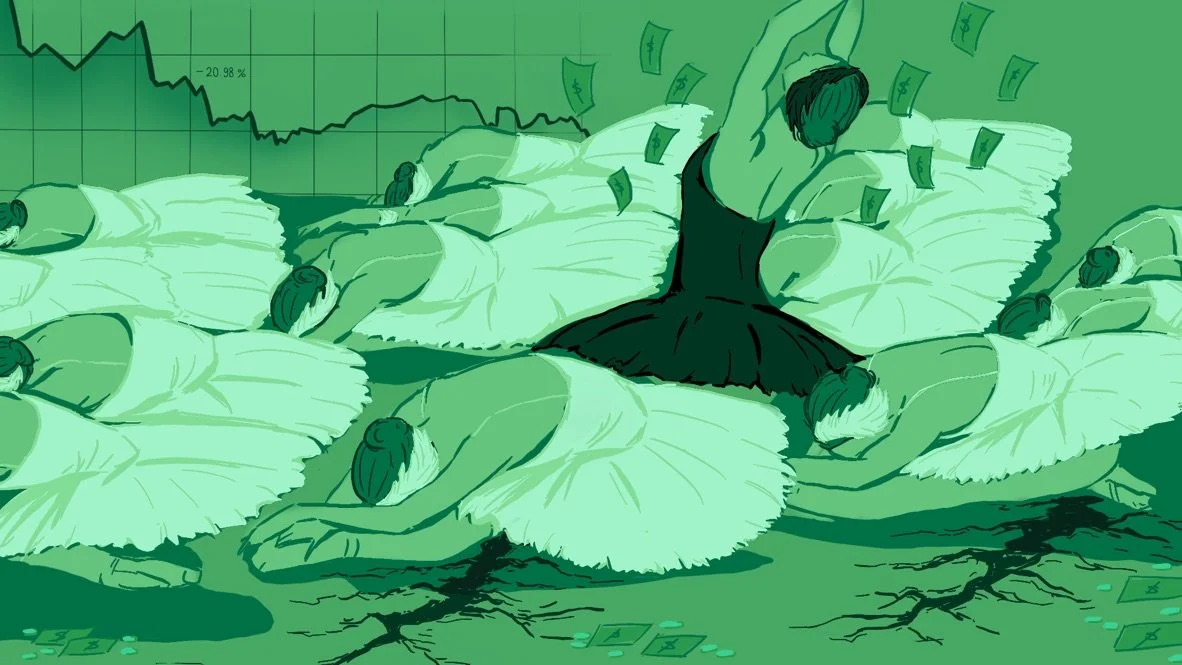Dancing with a Black Swan: The Corporate Debt Illusion
Illustration by Renee Xia
For the past decade, corporations have waltzed with cheap debt. Due to low interest rates making borrowing easy, corporations often assumed that refinancing would be readily available and rolling over debt became an easy practice. The financial stage was set, the music played, and investors continued to applaud at the spectacle.
Now, central banks are tightening monetary policy, and borrowing costs have surged; a choreography of risk is under strain. Could the next financial crisis emerge not from equity markets or government debt, but from the dark corners of corporate borrowing?
The Rise of Corporate Leverage
Glocal corporate debt has exploded, reaching almost $24 trillion USD by July 2024. In the past, low interest rates encouraged aggressive borrowing for acquisitions, share buybacks, and expansions. Leveraged loans, private credit, and covenant-lite bonds proliferated, offering high yields with an apparent level of safety. However, refinancing, which was once effortless, now faces friction. Companies expecting easy access to capital confront maturities that may be impossible to roll over without pain. Analysts are expecting that emerging markets’ leverage to grow twice as fast as that of mature markets.
Shadow Banking and Hidden Risk
Most of this debt is outside traditional banking oversight. Private credit funds, leveraged loan syndications, and other shadow banking mechanisms quietly absorb risk with minimal transparency. Contrary from regulated banks, shadow lenders often lack capital buffers and standardised reporting. Further, rising interest rates could magnify defaults and ripple across the corporate and financial ecosystem. The opacity of these structures indicates that stress points may exist unnoticed. Risks that, if triggered, could surprise even seasoned investors.
Lessons from Past Black Swans
History is often the best place to look and offers many cautionary tales. The 1998, the LTCM collapse threatened global markets, caused by the leverage in opaque structures. Followed by the 2008 Financial Crisis, when mortgage debt cascaded through institutions, assumptions about liquidity failed.
Nassim Nicholas Taleb’s The Black Swan reminds us that rare, high-impact events often appear impossible beforehand, yet are visible in hindsight. Today, corporate debt mirrors these patterns of low transparency, high leverage, and reliance on market assumptions that may no longer hold.
As of right now, even a small shock, a sudden interest rate hike, sector downturn, or liquidity squeeze. All that could trigger widespread contagion.
Macroeconomic Events that Could Trigger a Crisis
Several macroeconomic shifts could catalyze a corporate debt crisis:
Persistent Inflation - Continuing hikes in the rates increase the borrowing costs for firms with rolling debt
Economic Slowdown - Debt servicing becomes challenging and puts a strain on revenues
Market Volatility - The decline in credit markets could limit refinancing options, particularly in regards to covenant-lite loans
Sector-Specific Shocks - Industries such as energy, real estate, and technology that are highly indebted could face acute liquidity issues
These factors combined create a scenario where the corporate debt landscape could suddenly unravel, thus producing a Balck Swan Event.
Why This Matters
Corporate debt often escapes headlines dominated by tech IPOs or government borrowing; however, the potential impact is systemic. Private credit firms have doubled in the past few years and surged past $ 2 trillion USD, with a significant exposure to leveraged loans. The risk of defaults is rising sharply and could cascade through supply chains, investment funds, and traditional banks. The choreography of cheap credit has lulled investors and regulators into severely underestimating risk. By focusing on equity and government debt, the hidden fragility in corporate borrowing remains underappreciated.
The Final Act
As central banks continue to maintain a higher-for-longer stance and maturities approach, the corporate debt ballet is reaching its final act. Firms that are relying on cheap credit may find themselves overleveraged and underprepared. Defaults could ripple through shadow banking channels, credit funds, and traditional banking, revealing systemic fragility.
Corporate debt is the quiet performer in the financial theatre, always present, rarely noticed, yet it has the power to unravel the entire act with a small misstep. Understanding and monitoring these risks may not even be an option anymore, because whether the next shock is anticipated or unfolds as a Black Swan, the applause may have been premature.



